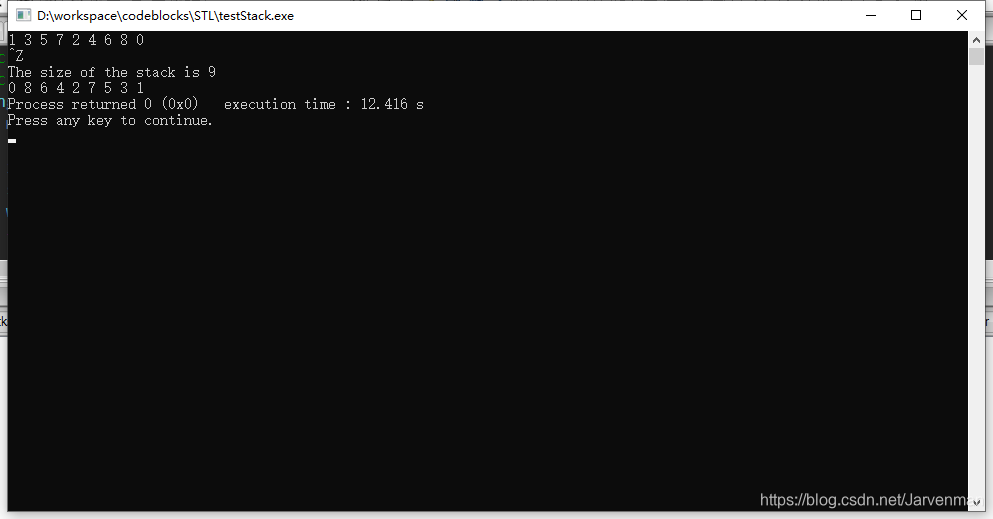版权声明:原创文章,但可以转载哦~ https://blog.csdn.net/Jarvenman/article/details/88735064
优先队列的某些部分,参考了另一篇博文,那篇博文里还有一些关于优先队列的其他东西,但是我觉得用处不大,所以没有写下来,读者有兴趣可以看一下
https://www.cnblogs.com/xzxl/p/7266404.html
一、stack —— 栈,后进先出
常用函数:
#include<stack> //头文件
stack<int> q; //定义q
q.top(); //获取栈顶元素(不删除)
q.pop(); //删除栈顶元素
q.push(x); //x入栈
q.empty(); //判断栈空否 while(!q.empty()){...}
q.size(); //返回栈的大小
代码示例:
#include<iostream>
#include<stack> //stack头文件
using namespace std;
int main()
{
int x;
stack<int> q; //初始化栈
while(cin>>x)
{
q.push(x); //入栈
}
cout<<"The size of the stack is "<<q.size()<<endl; //输出栈的大小
while(!q.empty())
{
cout<<q.top()<<" "; //输出栈顶元素
q.pop(); //栈顶元素出栈 应该与入栈顺序相反
}
}
输出样例:(^z是终止符)

二、queue —— 队列,先进先出
常用函数:
#include<queue> //头文件
queue<int> q; //定义q
q.front(); //获取队首元素(不删除)
q.pop(); //删除队首元素
q.push(x); //x入队
q.empty(); //判断队空否 while(!q.empty()){...}
q.size(); //判断队的大小
代码示例:
#include<iostream>
#include<queue> //queue头文件
using namespace std;
int main()
{
int x;
queue<int> q; //初始化队列
while(cin>>x)
{
q.push(x); //入队
}
cout<<"The size of the queue is "<<q.size()<<endl; //输出队列的大小
while(!q.empty())
{
cout<<q.front()<<" "; //输出队列元素
q.pop(); //元素出队 应该与入队顺序相同
}
}
输出示例:

三、优先队列:
优先队列容器与队列一样,只能从队尾插入元素,从队首删除元素。但是它有一个特性,就是队列中最大的元素总是位于队首,所以出队时,并非按照先进先出的原则进行,而是将当前队列中最大的元素出队。这点类似于给队列里的元素进行了由大到小的顺序排序。元素的比较规则默认按元素值由大到小排序,可以重载“<”操作符来重新定义比较规则。(摘自参考博客)
常用函数:
#include<queue> //头文件,和queue一致
priority_queue<int> q; //定义优先队列,元素从大到小排序
priority_queue<int, vector<int>, greater<int> > p; //定义优先队列,元素从小到大排序
q.top(); //获取队优先级最高的元素(不删除),注意哦,这里和queue不一样,反而和stack是一样的
q.pop(); //删除优先级最高的元素
q.push(x); //x入队
q.empty(); //判断队空否 while(!q.empty()){...}
q.size(); //返回队的大小
代码示例:
#include<iostream>
#include<queue>
#include<vector>
using namespace std;
int main()
{
priority_queue<int> q; //定义优先队列,元素从大到小排序
priority_queue<int, vector<int>, greater<int> > p; //定义优先队列,元素从小到大排序
int x;
while(cin>>x)
{
q.push(x);
p.push(x);
}
while(!q.empty())
{
cout<<q.top()<<" ";
q.pop();
}
cout<<endl;
while(!p.empty())
{
cout<<p.top()<<" ";
p.pop();
}
}
输出样例:

这里还有一种情况,是如果优先队列里装的是我们自己定义的结构体呢?如何自定义优先级?
看如下代码:
struct Node
{
int x, y;
friend bool operator < (Node a, Node b) //friend是C++中的关键字,意为“友元”
{
return a.x > b.x; //x小的优先级高一些
}
};
整段代码如下:
#include<iostream>
#include<queue>
using namespace std;
struct Node
{
int x, y;
friend bool operator < (Node a, Node b) //friend是C++中的关键字,意为“友元”
{
return a.x > b.x; //x小的优先级高一些
}
};
int main()
{
priority_queue<Node> p;
int nx, ny;
while(cin>>nx>>ny)
{
Node n;
n.x = nx;
n.y = ny;
p.push(n);
}
while(!p.empty())
{
cout<<p.top().x<<" "<<p.top().y;
p.pop();
cout<<endl;
}
}
输出示例如下:
